History
What was the Roman Empire?
Although the Roman Empire originated in Italy, it did not stay there. The Romans expanded and conquered many countries inside and outside of Europe.
The Roman Empire lasted from 700BC to AD476.
The empire was huge and stretched across Europe, North Africa and Asia.
There were enslaved people and citizens in the Roman Empire.
Ancient Rome brought in people and influences from across the world and we know this because of things like the writings of Roman scholars, items archaeologists have found and extraordinary buildings that still remain today, centuries later. It's fascinated people for thousands of years!
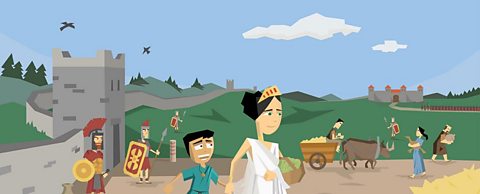
Ancient Roman society and culture
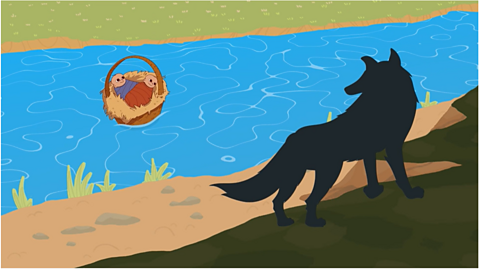
Ancient Rome was a bustling city. It had many features that modern cities have including markets, bakeries and libraries. There were even toilets and sewers!
According to Roman legend, the city of Rome was founded by twin brothers Remus and Romulus. The legend states that they were rescued by a wolf after being abandoned in the River Tiber. It is said that they built a town in the same area they were rescued.
However, the legend tells us that one day Remus and Romulus had a fight in which Remus was killed. Therefore, Romulus was now in charge in the city.

The Romans: Society and Culture
BBC Teach: KS2 History
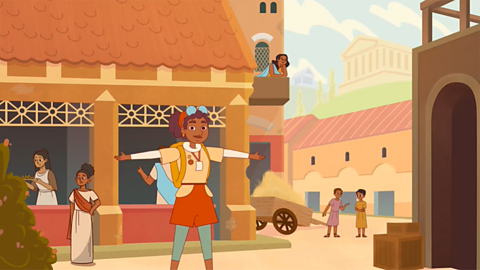
Growing up in ancient Rome
BBC Teach: KS2 History
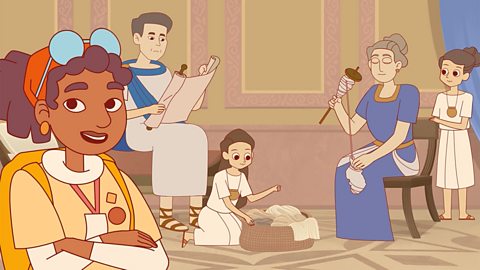
Quiz: Society and culture
How did the Romans conquer Britain?

Around 2,000 years ago, Britain was ruled by tribes of people called the Celts. But this was about to change.
For around 100 years, the Roman army had been building an empire across Europe.
The Romans wanted Britain's precious metals like gold, tin and iron – and its cattle.
A number of Roman emperors also wanted the glory of conquering Britain and adding it to the empire.

Why did the Romans invade Britain?
Over 2,000 years ago, the Romans first arrived in Britain. Although that was way back in the past, many clues still survive which tell us what life was like during Roman times.
From the remains of ancient forts to the jewellery, letters and household items still being dug up by archaeologists today. We can find out brilliant details of what they ate, what their homes looked like and even what they did for fun.
And thanks to a book written all those years ago by the famous Roman commander, Julius Caesar, we also know one reason why the Romans wanted to come to Britain in the first place - they wanted to make use of the amazing natural resources to be found here.
Caesar wrote, "The Britons have a huge number of cattle, they use gold coins or iron bars as their money, and produce tin and iron." That description helps to explain why Caesar and his army decided to pile over here to Britain to try to invade. Rome wanted to get its hand on all those British resources to make itself even richer.
Back then, before the Romans invaded, we didn't have one king or queen ruling over the nation. Britain was made up of different groups, or tribes, known as the Celts or native Britons.
We get an idea of what the native Britons looked like thanks to a description of them in here. But do remember, of course, they were Caesar's enemy, so his opinion might be a little bit one-sided. "All Britons used woad to dye their bodies a blue colour, which makes them terrifying when they are fighting in battle."
The Celts also put lime in their hair to make it stiff and thick, which made them look even more ferocious. "They used their chariots in battle, steering them in all directions while hurling their weapons, generally causing the enemy to separate apart. Then one of the warriors leaps from the chariot and fights on foot."
It was all just too much for Caesar. He invaded the country twice, but he never actually managed to take over. That would have to wait until 100 years later when the Emperor Claudius tried again and this time, he succeeded. And that is how we became part of the Roman Empire.
In 54-55BC, Julius Caesar tried to invade but failed.
In AD43, ordered by Emperor Claudius, a big Roman army landed on the beaches in Kent.
Over the next year it battled inland, storming through hillforts and conquering anyone who stood in their way.
Romans in Britain
BBC Teach
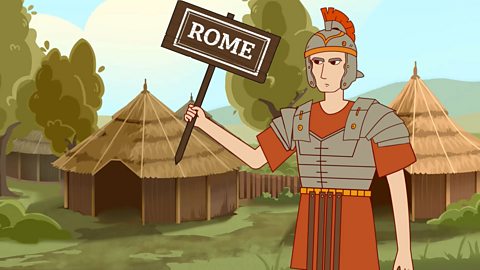
The Roman Army
BBC Teach
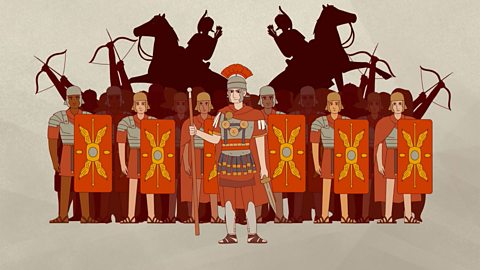
How the Romans conquered Britain
Bitesize: KS2 History
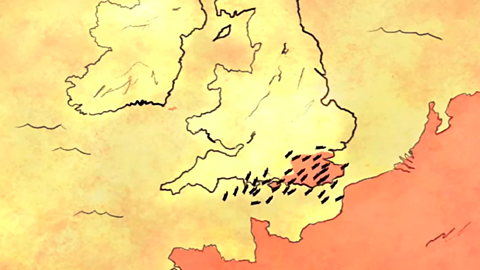
Who was Queen Boudicca?
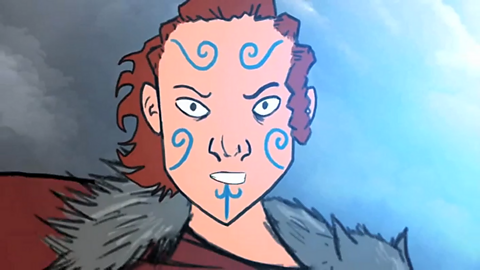
If the Celts made peace with the Romans, they agreed to obey Roman laws and pay taxes. In return, they could keep their kingdoms.
However, some Celtic leaders chose to fight.
In AD60, one leader who chose to fight was Queen Boudicca of the Iceni tribe.

Find out why Queen Boudicca led a rebellion against the Romans.
Boudicca: I am Boudicca, Queen of the Iceni. When my husband died, he left his kingdom both to me and the Roman emperor, Nero, to share.
It was meant to keep the peace between us.
Narrator: It is 60AD. The Romans have invaded and taken over much of southern Britain.
Some of the native British tribes have agreed to support and work with the Romans, but others are not so happy.
The Roman army is heading to North Wales, but elsewhere, trouble is brewing – led by Boudicca.
Boudicca: But the Romans want it all!
Nero had me whipped in front of my people. He demands we pay taxes on land that belongs to us.
Beretta: She is magnificent.
Boudicca: Fight with us.
Beretta: I want to fight too. I want to be like Boudicca.
Beretta’s Father: No, Beretta.
Beretta: You named me Beretta, Beretta means strong.
Beretta’s Father: Yeah, that was a mistake.
Narrator: Beretta and her father follow Boudicca and her army. They head for Colchester, an important Roman town, and burn it to the ground.
Boudicca: What’s your name?
Beretta: Beretta.
Boudicca: You live up to your name. And now, onto Londinium.
Boudicca raised a huge army and burned the Roman towns of Colchester and London, before heading north to St Albans.
When the Roman army heard about this, they turned back from Wales to face her.
Even though the Romans were outnumbered by Boudicca's 200,000 warriors, they were better trained and had better armour.
Both sides clashed in a fierce battle, but the Romans won.
What happened when Boudicca faced the Roman army?
Was Boudicca’s rebellion a success?
After burning down Colchester, Boudicca's army destroyed the Roman town of London, before heading north to St Albans.
Meanwhile, the Roman army is busy conquering Wales. But messengers soon bring them news of Boudicca's campaign, and their plans are changed.
“The Britons have done too much damage. If we don't defeat them now, we will have to leave these islands and all the riches they contain. We must end their revolt once and for all.”
Native British warriors blow war horns, known as carnyx, to put fear into the Romans and are experts at driving two-wheeled chariots. They use iron-tipped spears and long slashing swords, but wear little armour. They don't fear death, believing they will come back braver and stronger in their next life.
“Charge!”
Roman soldiers are put into groups of around 6,000 men known as legions. The Roman army is well armed, very skilled at working together and heavily protected by armour.
Britons outnumber the Romans by up to 20-to-1, but the Roman soldiers are highly trained. Boudicca and the Britons are defeated. Around 80,000 Britons are killed. Rome will control most of Britain for the next 350 years.
“Welcome, men, this is Roman Britain.”
What was life like in Roman Britain?
The Roman invasion of Britain was one of the most significant events ever to happen to the British Isles.
The Romans affected our language, our culture, our geography, our architecture and even the way we think. One of the most significant changes they made to Britain was the introduction of stone roads rather than muddy tracks.
What was life like in Roman Britain?
Bitesize: KS2 History
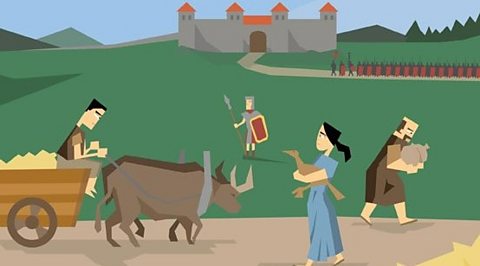
How did the Romans change Britain?
Bitesize: KS2 History
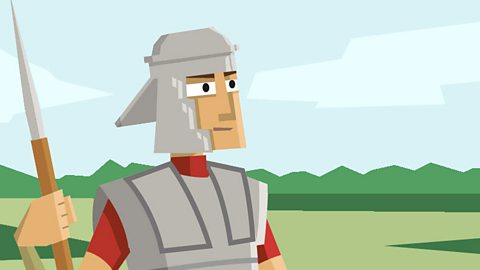
Roman Roads
BBC Teach: Explain This...

Quiz
English
Latin root words
Latin was a language that was used during Ancient Rome. Whilst Latin is not spoken now, many European languages, including English, have some roots in the ancient language.
Many common English words have their roots in Latin. They are called Latin root words.
Here are some examples of root words that can unlock some tricky vocabulary.
Aqua: Water, as in "aquifer" and "aquatics"
Aud: To hear, as in "audio" and "audience"
Bene: Good, as in "beneficial" and "benefactor"
Quiz
Maths
Roman numerals
The Romans used a different numbering system from the one that we use today. Their numbers were shown by letters. These are called Roman numerals.
I = 1, V = 5, X = 10, L = 50 and C = 100
V is 5, so VI is 5 + 1 which is 6.
If the smaller value is after/to the right of a larger number, it's added on.
If the smaller value is before/to the left of the larger value, it's taken off. With the example of:
I = 1, II = 2, V = 5
IV (I to the left of the V, so it's taken off) = 4
VI (I to the right of the V, so it's added on) = 6
VII (II to the right of the V so it is added on) = 7
Geography
Life in modern Rome
Rome is the capital of modern day Italy.
Rome has transformed over the past 2,000 years. But it is still well known for its culture, fashion, food and famous monuments.
Famous places include the Trevi Fountain, the River Tiber and many churches.
The Vatican, which is a separate state in itself, is where the Pope lives and works. Catholics from across the world come to The Vatican to worship.
Watch Daniel and Eduardo as they teach us about modern Rome.
DANIEL AND EDUARDO: Benvenuti a Roma!
DANIEL: Rome is the capital of Italy. It's a big city. And it's very near the sea.
I'm Daniel. I came to live here three years ago with my family.
And this is my friend, Eduardo.
Rome is so full of history. It's like a living museum.
There are heaps of monuments and cool ruins to explore.
Roma è piena di monumenti.
EDUARDO: Questo è il Foro Romano.
DANIEL AND EDUARDO: C'è anche tanta gente!
DANIEL: There's always lots of traffic, so it's very noisy.
Roma è una città molto rumorosa!
EDUARDO: Tanto caotica!
DANIEL: Rome can also be very quiet: tranquilla.
I love the view from this hill, because you can see all of Rome from up here.
There are lots of churches: chiese. And also the Vatican, which is a whole state in itself.
It's where the Pope lives. And people come from all over the world to visit.
The river Tiber, il Tevere, runs right through Rome.
There's a castle. Castel Sant'Angelo. And it's surrounded by angels.
Rome has hundreds of fountains: fontane. Including a rather famous one.
Questa è la fontana più famosa al mondo.
EDUARDO: La Fontana di Trevi.
DANIEL: They say if you throw a coin into the fountain, you'll always return to Rome.
Ma cosa ci sono con tutti quei soldi?
I wonder what they do with all that money.
BUKI: I'm Buki and this is my friend Eliane. We like to hang out with the cool cats.
Il mio posto preferito è quasi nascosto.
This is the place where Julius Caesar was killed. But now it's a sanctuary for cats.
Ci sono gatti di ogni colore. Neri e tigrati.
Questo gatto ha tre colori. Nero, bianco e arancione.
I'd love to take one home.
Italy has the best ice cream in the world. Gelato. And we eat it all year round.
There are hundreds of flavours: gusti. Which makes it very difficult to choose: cioccolato, vaniglia, pistacchio, fragola e stracciatella.
Buonissimo!
DANIEL: The Romans are also famous for the many roads they built all over the Roman empire.
This is the Appia Antica. The Romans built it over two and a half thousand years ago.
Back then it was 330 miles long. Now, it's a bit shorter, but it's the perfect place for a walk.
As they say, all roads lead to Rome!
ALL: Tutte le strade portano a Roma!
Quiz: Modern Rome
Where next?
KS2 Music: Rocking Romans!
BBC Teach: School Radio
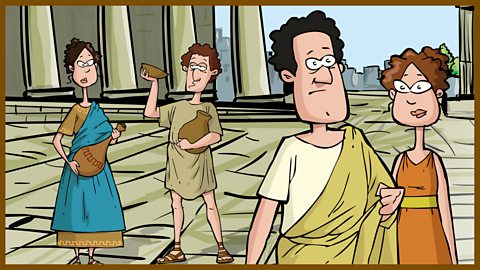
Roman Voices
BBC Teach
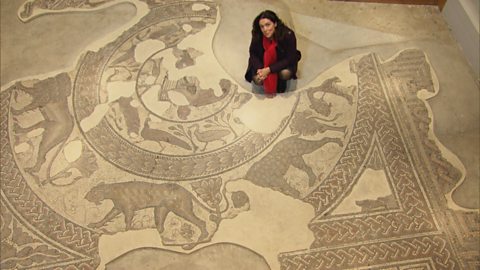
The Romans – History Live Lesson
BBC Teach: Live Lessons
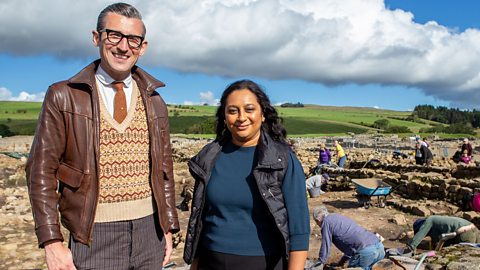
Easter Holidays Activity Pack activityEaster Holidays Activity Pack
Check out some Easter inspired activities to complete in the Easter Holidays, for KS1.

